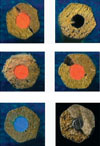
Where would you start if faced with the challenge to develop an automated sorting and ejector system that can sort two million pencils per day of different wood types, textures, and lead colours?
One company solved this problem by building a high-speed sorting system using the NI Vision Development Module, LabVIEW, digital image acquisition hardware, and IMAQ Vision Builder.
Eliminating defects with an automated system
Pencils consist of a pencil lead enclosed by a wooden casing. During the manufacture of pencils, leads are sandwiched between two wooden pieces, referred to as slats, and individual pencils are then separated by a sawing process.
During this process, a number of defects can be induced, such as missing leads, lead offset, and misalignment of slats. As a natural raw material, wood is prone to have defects, such as pieces chipped off, holes, and other faults that affect the pencil both functionally and aesthetically. Defects, such as lead offset, cause pencil leads to break during the sharpening process. Defective components must be removed before they are moved on to the subsequent processes of lacquering and finishing.
Prior to developing this sorting solution, more than 120 people were manually removing these flawed pieces and the quality of sorting was unsatisfactory. For example, lead offset has to be contained to within 300 microns for more demanding markets and it was impossible to reliably inspect such parameters manually. The quality of manual inspection was sub-standard, and the manufacturer was calling for a fully-automated system to perform this critical function.
The project specification
The specification required:
* High-speed inspection and sorting of pencils at more than 23 pencils per second.
* Sorting of pencils into different bins based on defect type. The requirement was to inspect the end faces of the pencils and classify the pencils into four categories: side A good, side B good, both sides good, and both sides bad. A side of the pencil is considered good if its edge face is clean without defects, such as lead centre offset, lead end defects, and cracks.

The manufacturer wanted a cost-effective test system that could provide:
* Flexibility to accommodate different categories of customers with different quality expectations. The system needed to be able to accommodate different types of pencils introduced in the future.
* An aggressive delivery schedule of 16 weeks for the complete sorting machine.
* A compact footprint to enable efficient use of valuable manufacturing floor space.
The successful machine builder presented a solution using line scan digital cameras and image processing software from National Instruments. LabVIEW Real-Time was considered to provide the hard, realtime response that is needed to precisely fire the ejectors but in the final instance a PCI-based solution was selected due to the higher processing power available on that platform. Benchmarking studies conducted with IMAQ Vision Builder clearly indicated the need for a 2,5 GHz processor.
Two cameras provide a complete view
The system that the machine builder created consists of two high-resolution, high-speed monochrome line scan cameras focused at opposite ends of the pencil. Motorised filter wheels enable an automatic filter change depending on the pencil lead colour. These cameras are connected to two separate PCI-1422 digital frame grabber cards and are positioned so the camera axis is in line with the pencil axis as it travels on the conveyer. Appropriate magnification optics and lighting equipment are provided.
The control unit of the conveyor is interfaced to the PCI-6025E data acquisition and control card to set the speed of the conveyor and to acquiring position information from a 2500 pulse per revolution encoder. The pneumatic ejection system is connected to the digital lines of the DAQ card through an interface card that synchronises the high-speed ejectors and drives the valves. A 2,5 GHz PC with high-speed RAM performs the image acquisition and processing. The PC is installed along with the external circuitry in an airconditioned panel to maintain constant conditions irrespective of the ambient.
The application software running in the PC processes the data acquired from both cameras. Based on the defect definitions, the system classifies images as either good or bad. The system then sends this information to the external interface card where it is stored in a FIFO memory buffer. This information from the PC, along with the encoder information and validity signals from the cameras is used to synchronise the ejectors.
A crucial part of the development cycle was the creation of image processing algorithms. They had to be sophisticated enough to detect the different defect types under varying conditions, and at the same time, perform within the very short time period available. NI Vision Builder for Automated Inspection, with its performance meter, helped to accomplish this task.
For more information contact National Instruments South Africa, 0800 203 199, [email protected], www.ni.com

© Technews Publishing (Pty) Ltd | All Rights Reserved